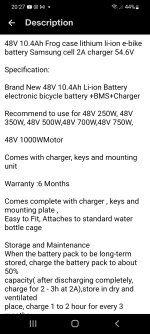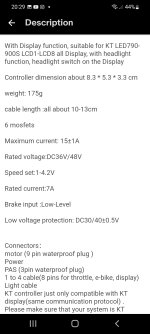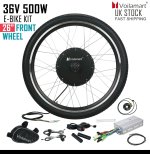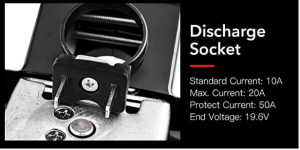Hi, here's another plea for help identifying the bms in a battery!
Recently bought this 48v frog battery from ebay, charged it up all good, but think I've buggered the bms as it's not charging anymore (light on charger stays green when plugged in), and pressing the test button on battery does nothing. If I press it while charging it briefly flashes red.
Anyway I've opened it up and tried to reset it by plugging the charger in with bms disconnected then reconnecting but that didn't work.
So now I'm looking at replacing the bms, but can't see any useful info on it and looking up the specific codes on it yield no results.

Did a Google translate too:

(Love how it's also translated the wires to WWVW!)
Tbh I don't really know what I'm doing. It's to connect to a 36v 500w voilamart front wheel which I bought after trying to connect the battery to my existing 36v 250w motor and it didn't improve performance.
Any help would be greatly appreciated
Recently bought this 48v frog battery from ebay, charged it up all good, but think I've buggered the bms as it's not charging anymore (light on charger stays green when plugged in), and pressing the test button on battery does nothing. If I press it while charging it briefly flashes red.
Anyway I've opened it up and tried to reset it by plugging the charger in with bms disconnected then reconnecting but that didn't work.
So now I'm looking at replacing the bms, but can't see any useful info on it and looking up the specific codes on it yield no results.

Did a Google translate too:

(Love how it's also translated the wires to WWVW!)
Tbh I don't really know what I'm doing. It's to connect to a 36v 500w voilamart front wheel which I bought after trying to connect the battery to my existing 36v 250w motor and it didn't improve performance.
Any help would be greatly appreciated







